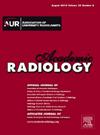超声波和乳腺 X 线照相术对核磁共振成像检测到的乳腺病变进行评估和活检的价值。
IF 3.8
2区 医学
Q1 RADIOLOGY, NUCLEAR MEDICINE & MEDICAL IMAGING
引用次数: 0
摘要
理由和目的:多参数乳腺磁共振成像检测出的可疑病灶可通过二维超声(SLUS)和/或乳腺X光检查进行进一步分析。本研究旨在评估第二视角成像在针对不同病变特征选择适当活检方法方面的价值:2021 年 1 月至 2023 年 12 月期间,212 名女性接受了 3 特斯拉对比增强多参数乳腺 MRI 检查。共有 241 个可疑病灶(108 个恶性肿瘤,占 44.8%)通过 SLUS 和二次乳房 X 光检查进行了进一步评估。随后在图像引导下使用最合适的方式对每个病灶进行活检。通过McNemar检验比较了SLUS和乳腺X光检查的病灶检出率:结果:在磁共振成像引导下进行活检的病变主要大小在10毫米以下(52.8%)。SLUS对肿块病灶的检出率高于乳腺X光检查(55.6%[95%置信区间46.4-64.4%]对16.7%[10.6-24.3%];P 10 mm (88.5% [69.9-97.6%]))。相比之下,SLUS 对恶性非肿块病灶的检出率低于二维乳腺 X 光检查(22.0% [11.5-36.0%] 对 38.0% [24.7-52.8%];p 结论:SLUS是对大于10毫米且无钙化的可疑肿块病灶进行进一步评估和活检的绝佳工具。相比之下,辅助超声在可疑非肿块病变的评估和活检指导方面的价值有限。本文章由计算机程序翻译,如有差异,请以英文原文为准。
The Value of Second-look Ultrasound and Mammography for Assessment and Biopsy of MRI-detected Breast Lesions
Rationale and Objectives
Suspicious lesions detected in multiparametric breast MRI can be further analyzed with second-look ultrasound (SLUS) and/or mammography. This study aims to assess the value of second-look imaging in selecting the appropriate biopsy method for different lesion characteristics.
Materials and Methods
Between January 2021 and December 2023, 212 women underwent contrast-enhanced multiparametric breast MRI at 3 Tesla. A total of 241 suspicious lesions (108 malignancies, 44.8%) were further assessed with SLUS and second-look mammography. Subsequent image-guided biopsy of each lesion was performed using the most suitable modality. Size-dependent lesion detection rates in SLUS and mammography were compared by means of the McNemar test.
Results
Lesions referred to MRI-guided biopsy were predominantly ≤ 10 mm in size (52.8%). SLUS allowed for higher detection rates than mammography in mass lesions (55.6% [95% confidence interval 46.4–64.4%] versus 16.7% [10.6–24.3%]; p < 0.001) with a particularly high sensitivity for malignant mass lesions > 10 mm (88.5% [69.9–97.6%]). In contrast, the detection rate for malignant non-mass lesions was lower in SLUS than in second-look mammography (22.0% [11.5–36.0%] versus 38.0% [24.7–52.8%]; p < 0.001). The malignancy rates in ultrasound-, mammography-, and MRI-guided biopsies were 53.7%, 55.2%, and 35.0%, respectively.
Conclusion
SLUS is an excellent tool for further assessment and biopsy of suspicious mass lesions > 10 mm without associated calcifications. In contrast, supplemental ultrasound is of limited value in the evaluation and biopsy guidance of suspicious non-mass lesions compared to second-look mammography.
求助全文
通过发布文献求助,成功后即可免费获取论文全文。
去求助
来源期刊

Academic Radiology
医学-核医学
CiteScore
7.60
自引率
10.40%
发文量
432
审稿时长
18 days
期刊介绍:
Academic Radiology publishes original reports of clinical and laboratory investigations in diagnostic imaging, the diagnostic use of radioactive isotopes, computed tomography, positron emission tomography, magnetic resonance imaging, ultrasound, digital subtraction angiography, image-guided interventions and related techniques. It also includes brief technical reports describing original observations, techniques, and instrumental developments; state-of-the-art reports on clinical issues, new technology and other topics of current medical importance; meta-analyses; scientific studies and opinions on radiologic education; and letters to the Editor.
 求助内容:
求助内容: 应助结果提醒方式:
应助结果提醒方式:


